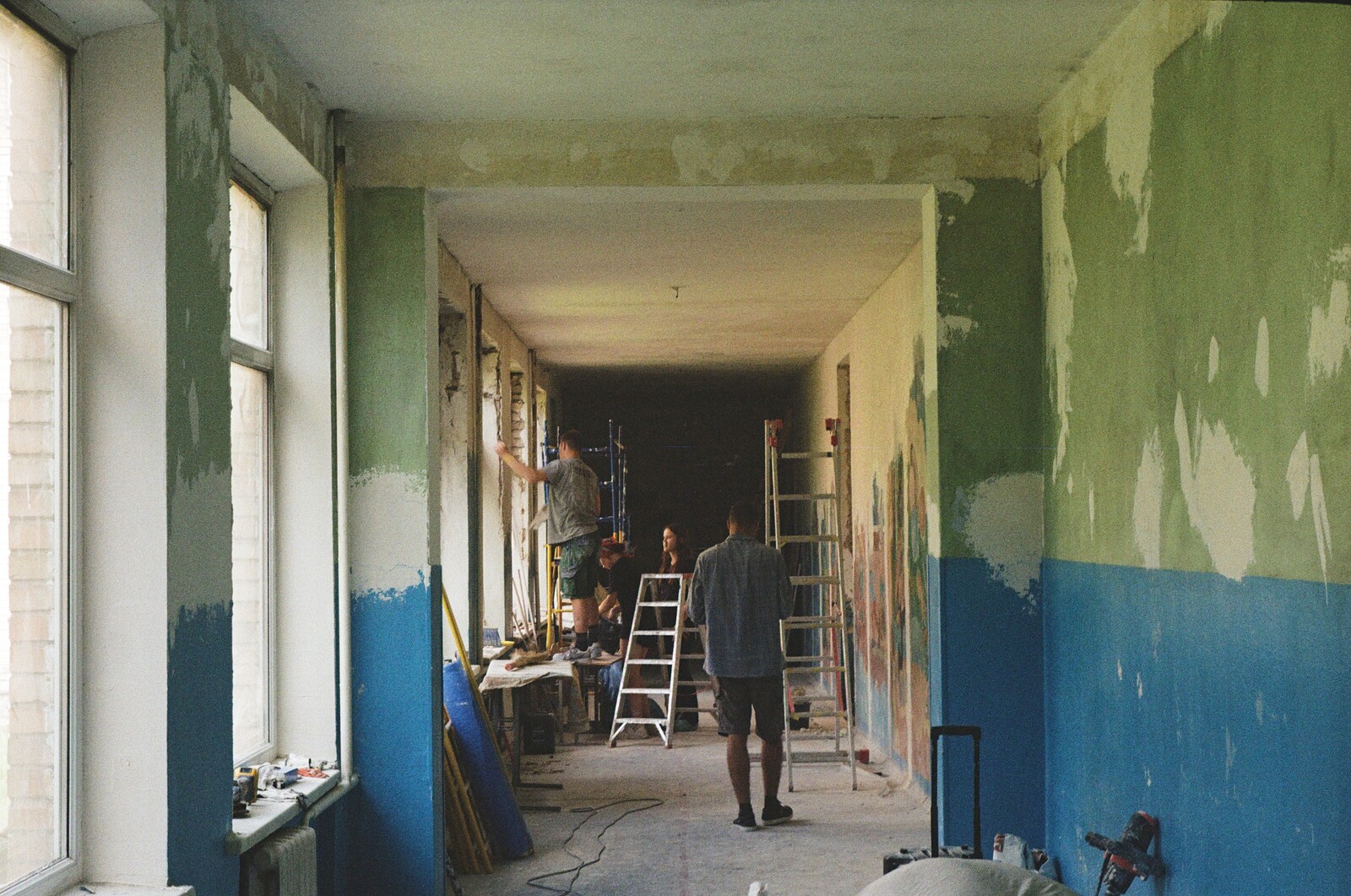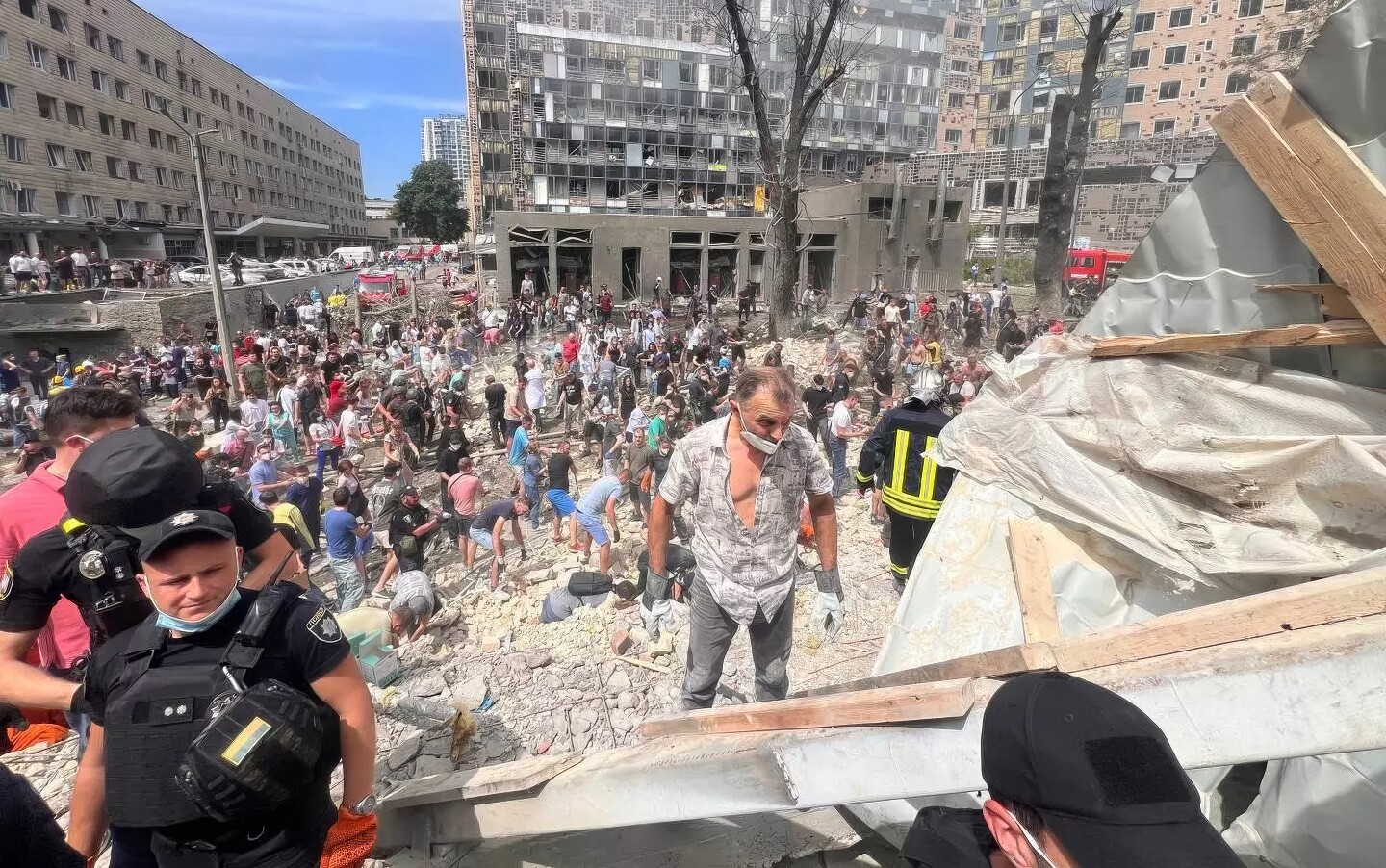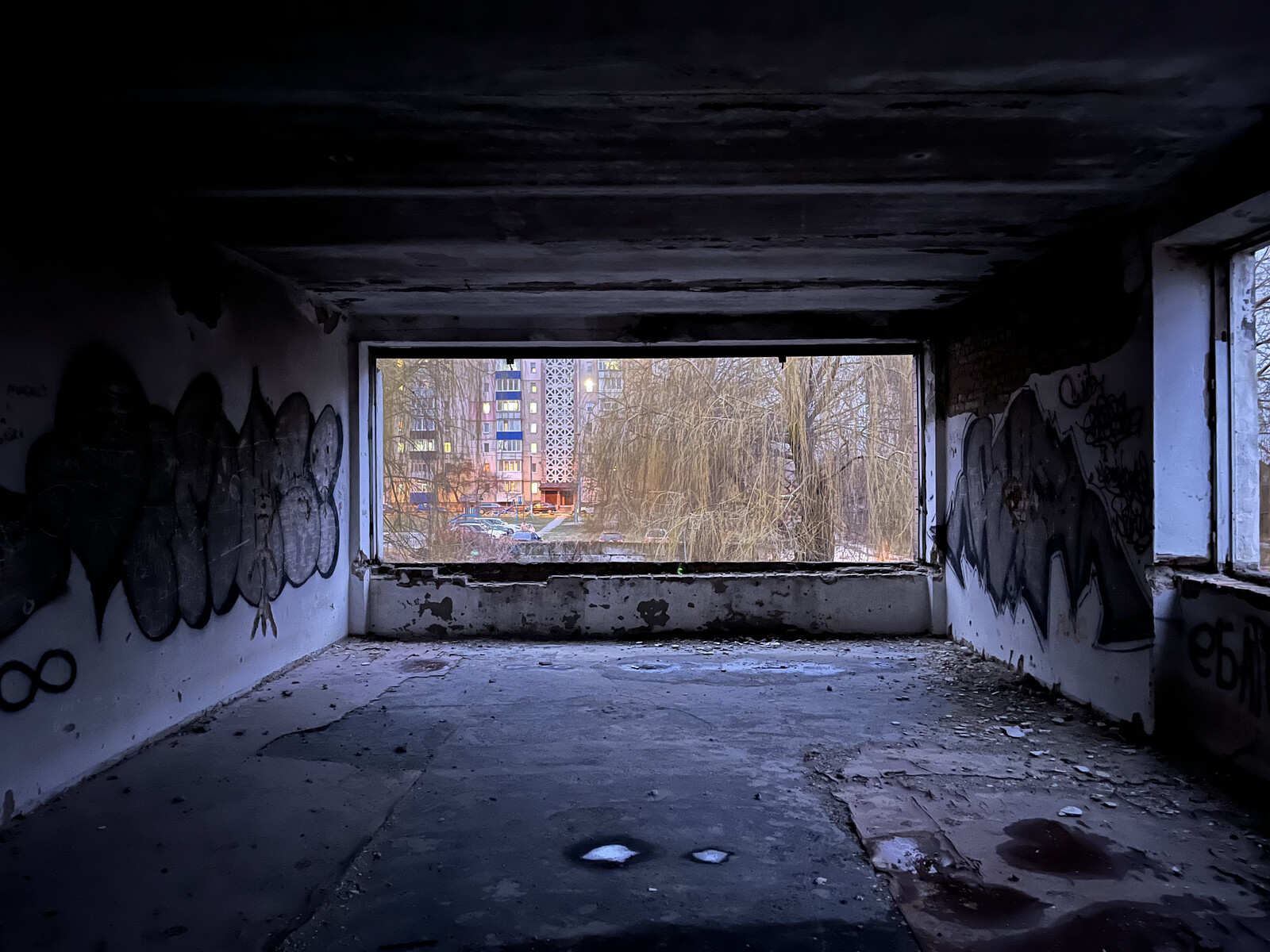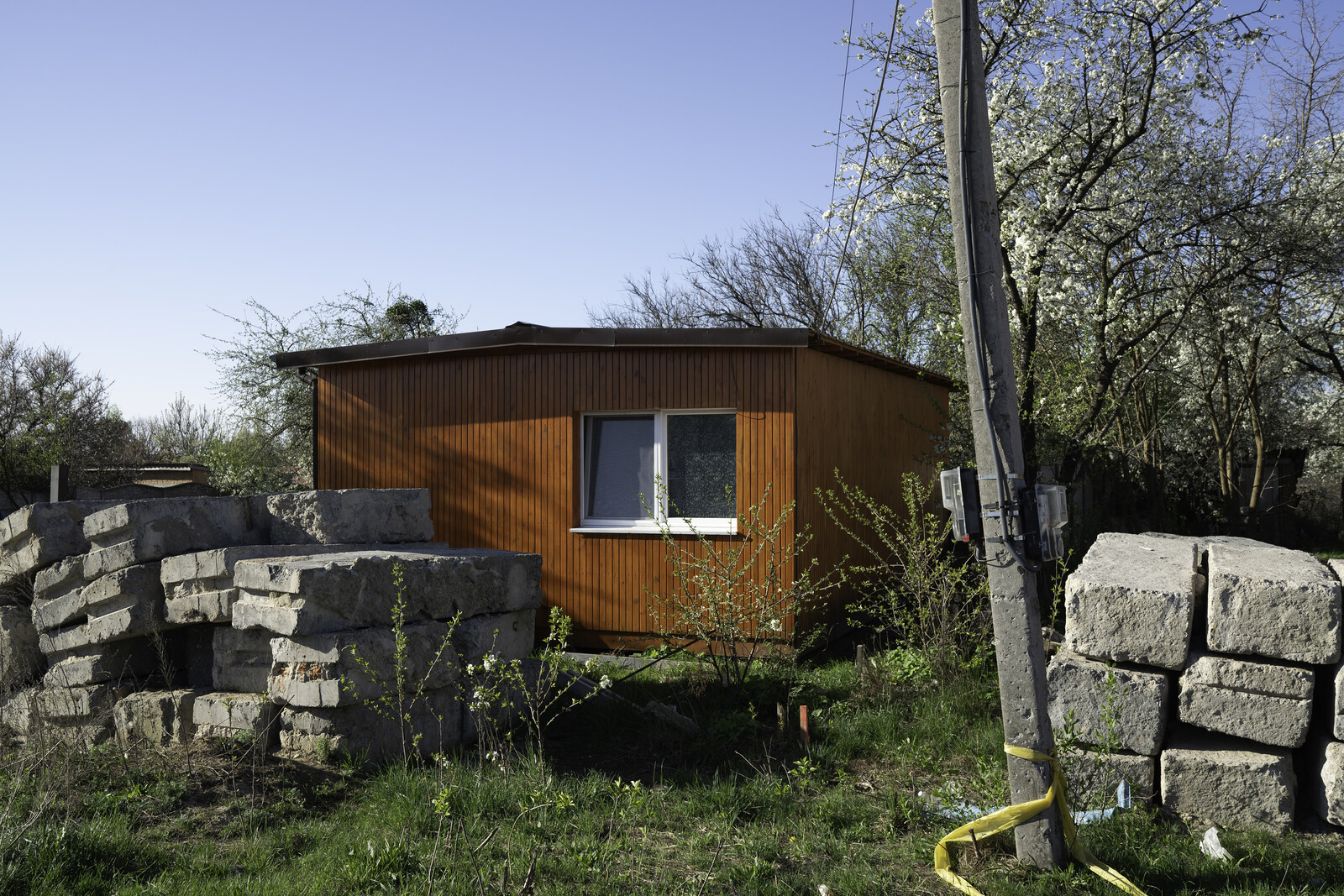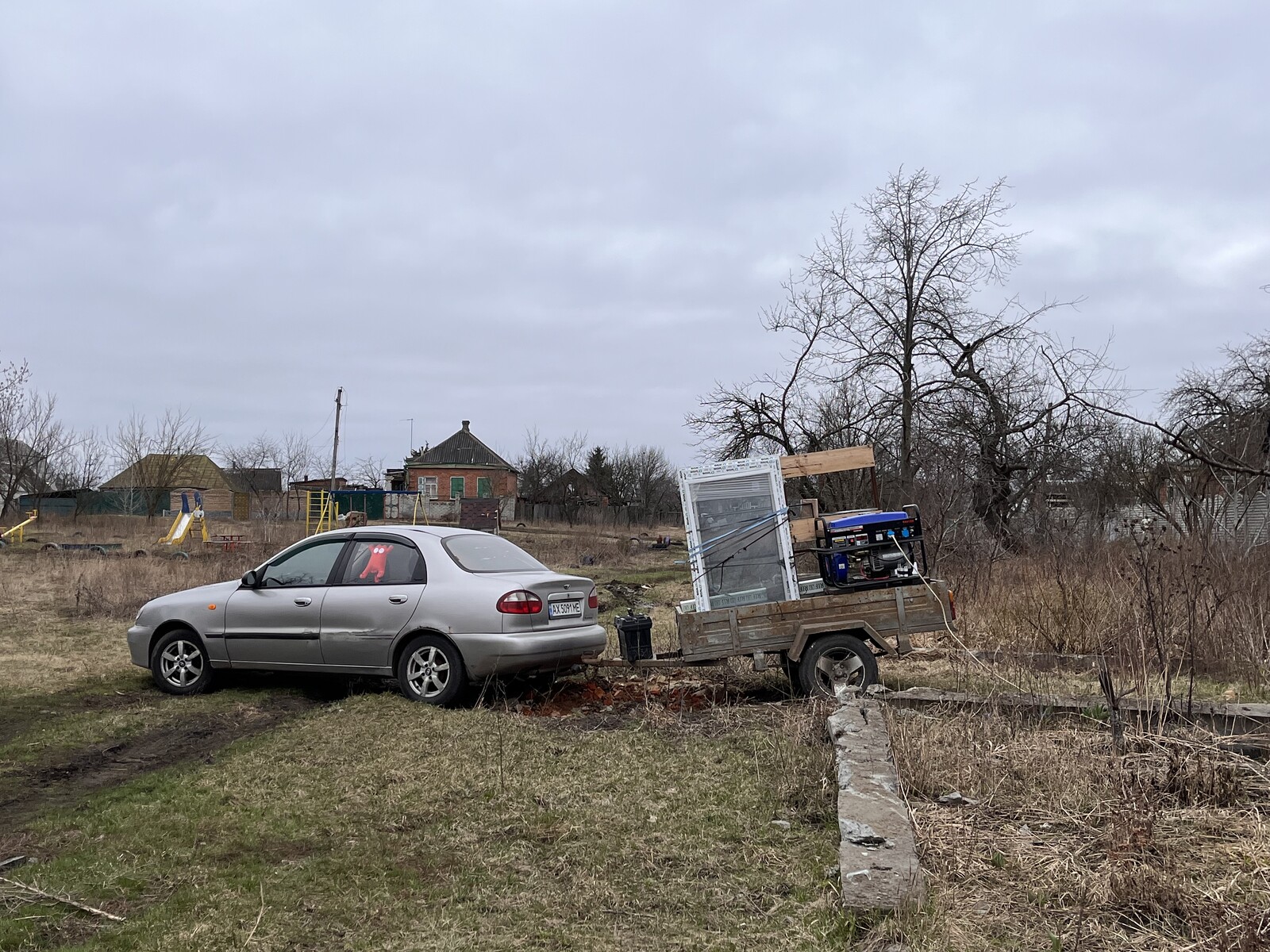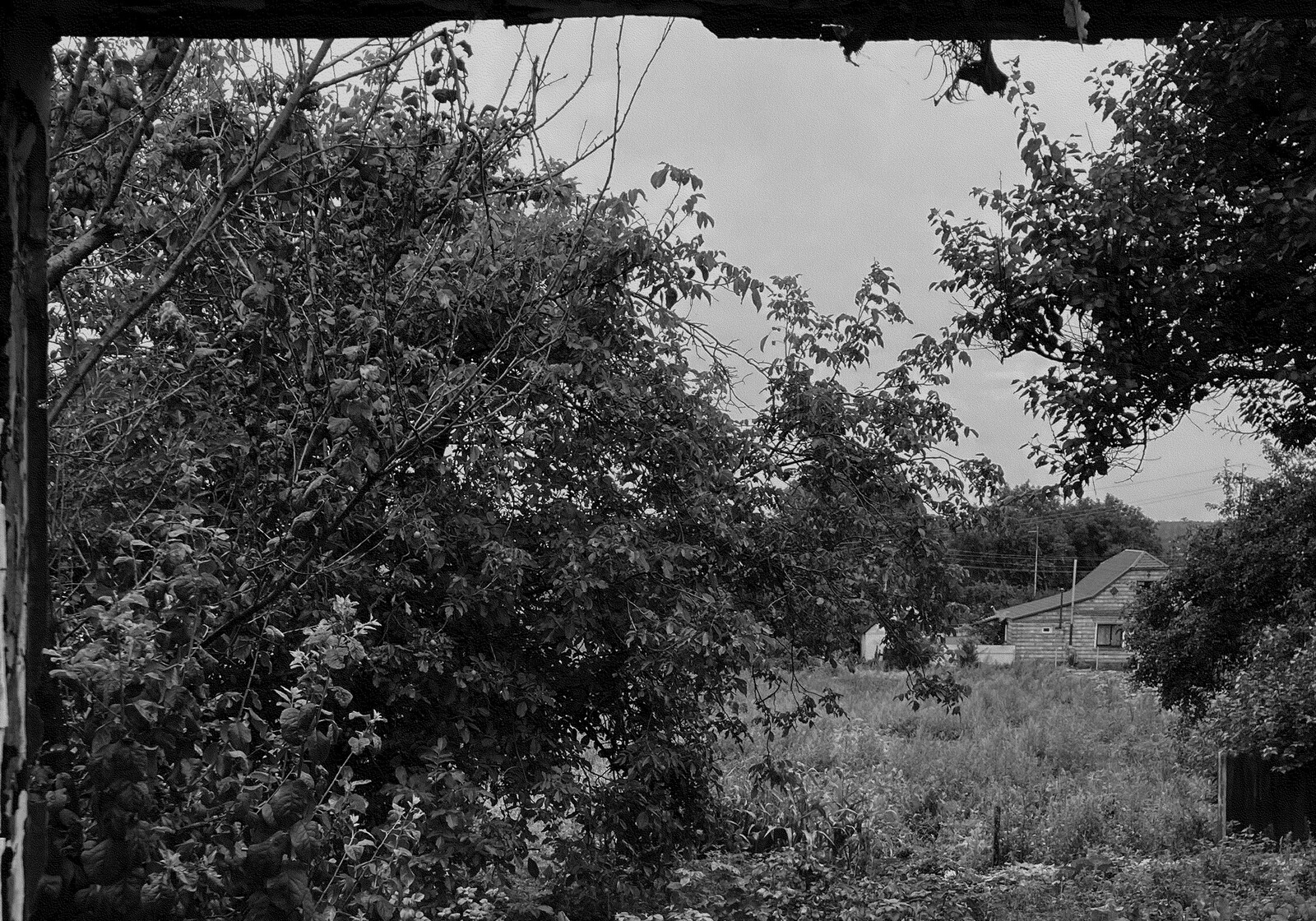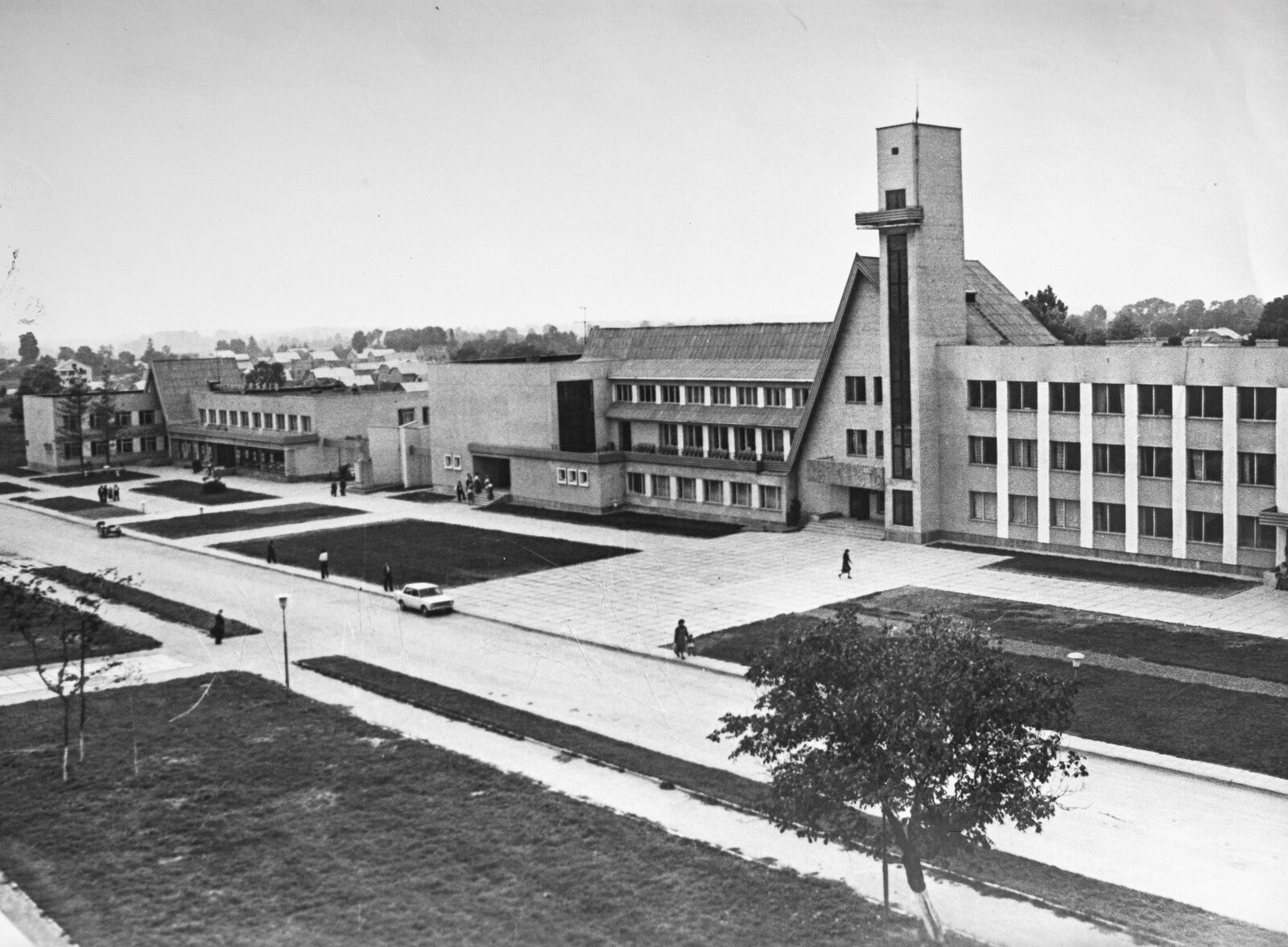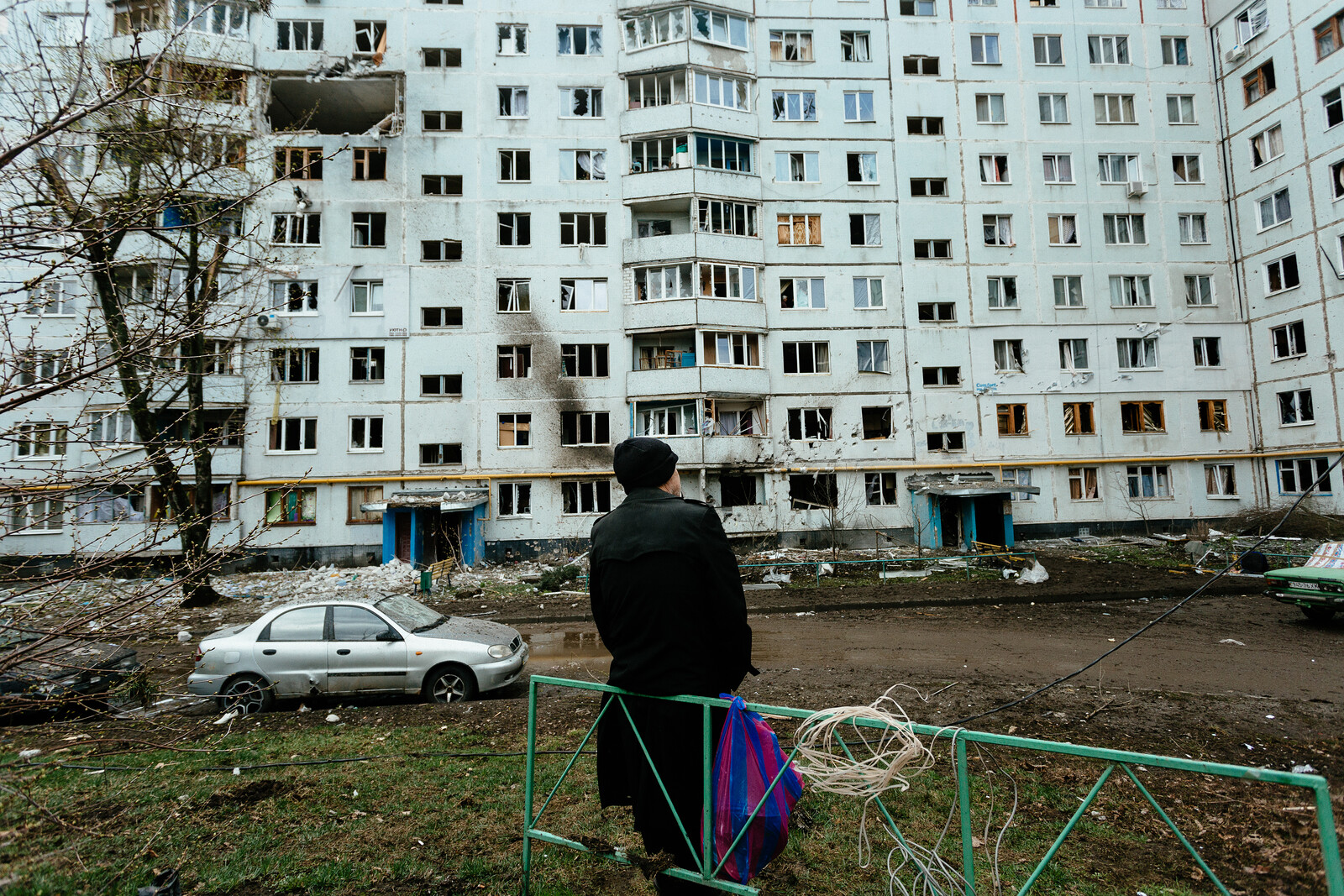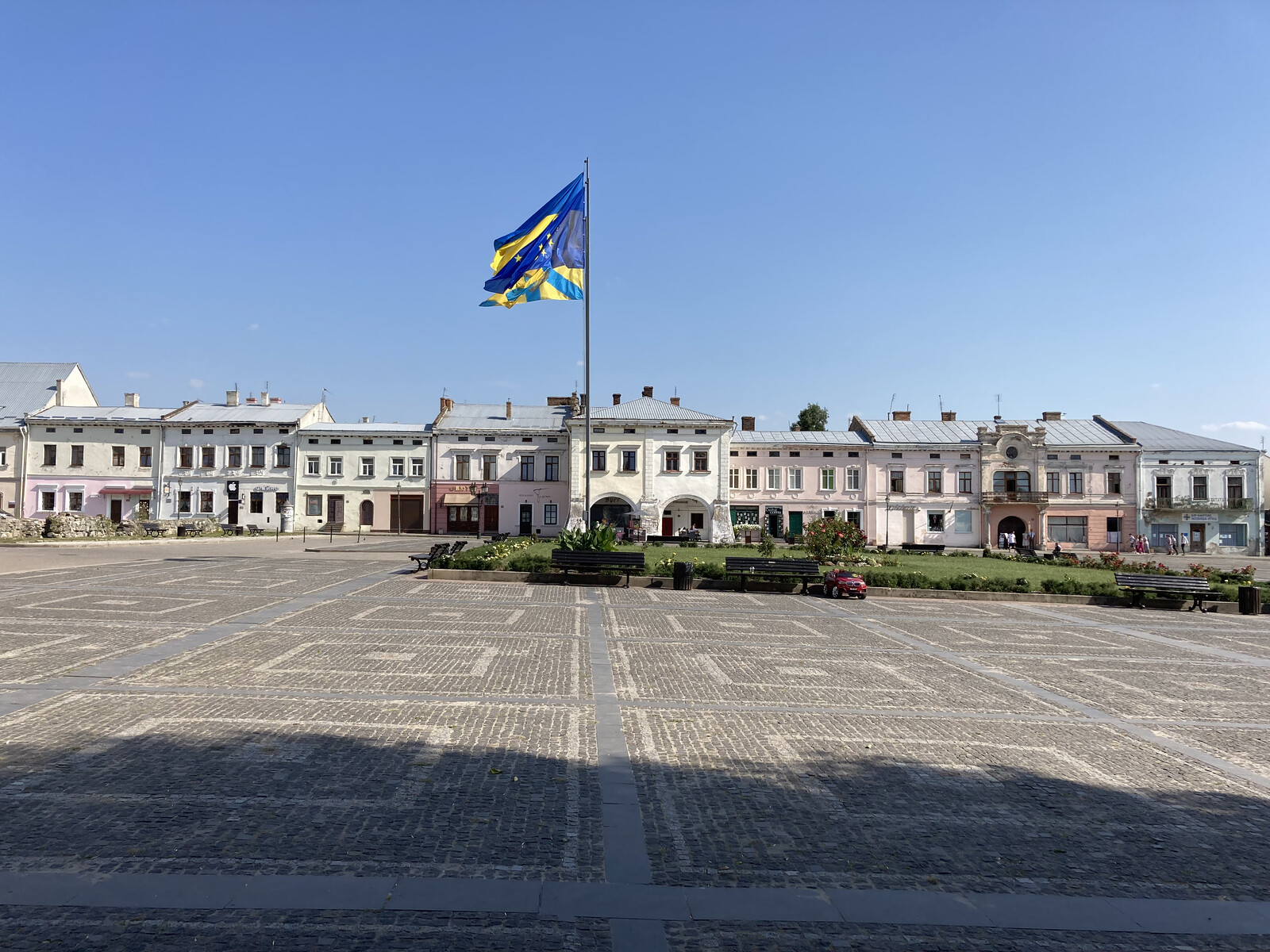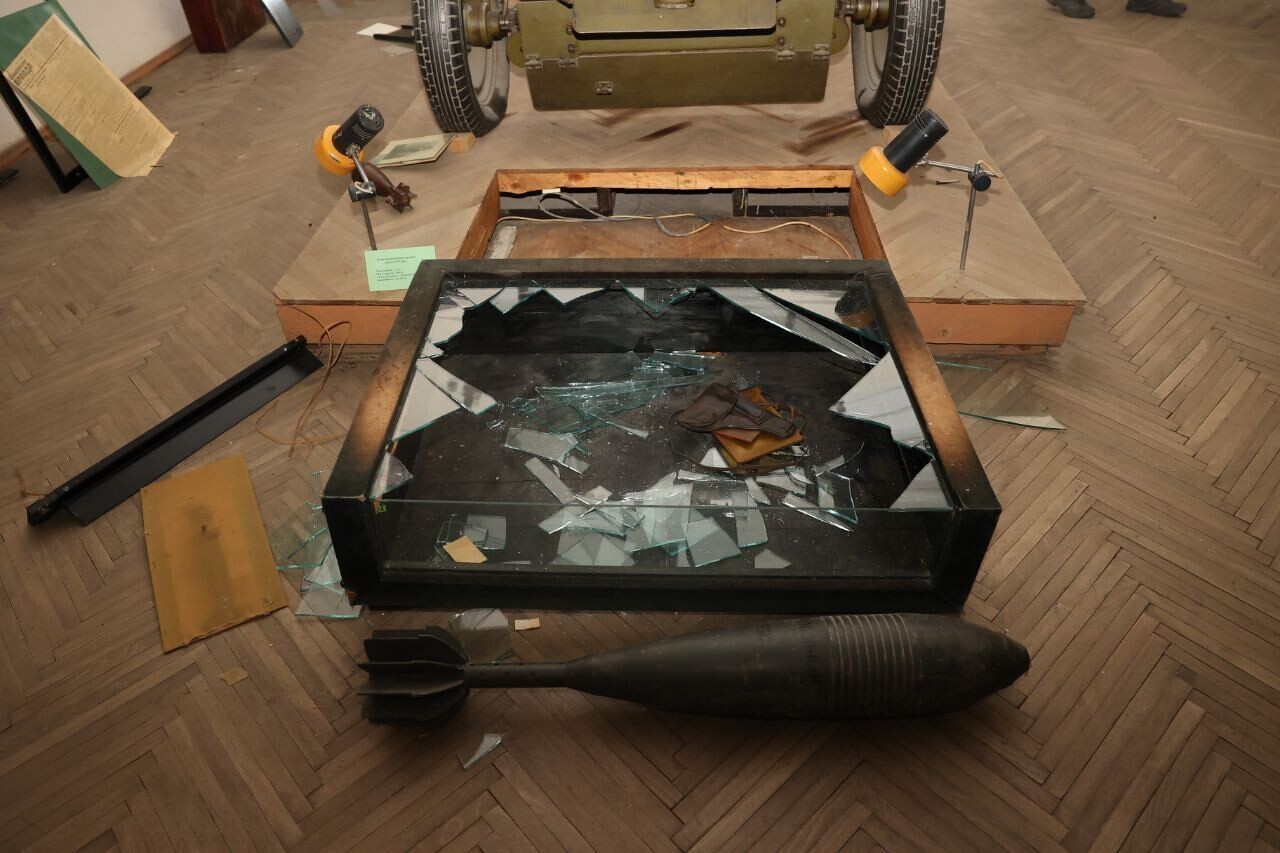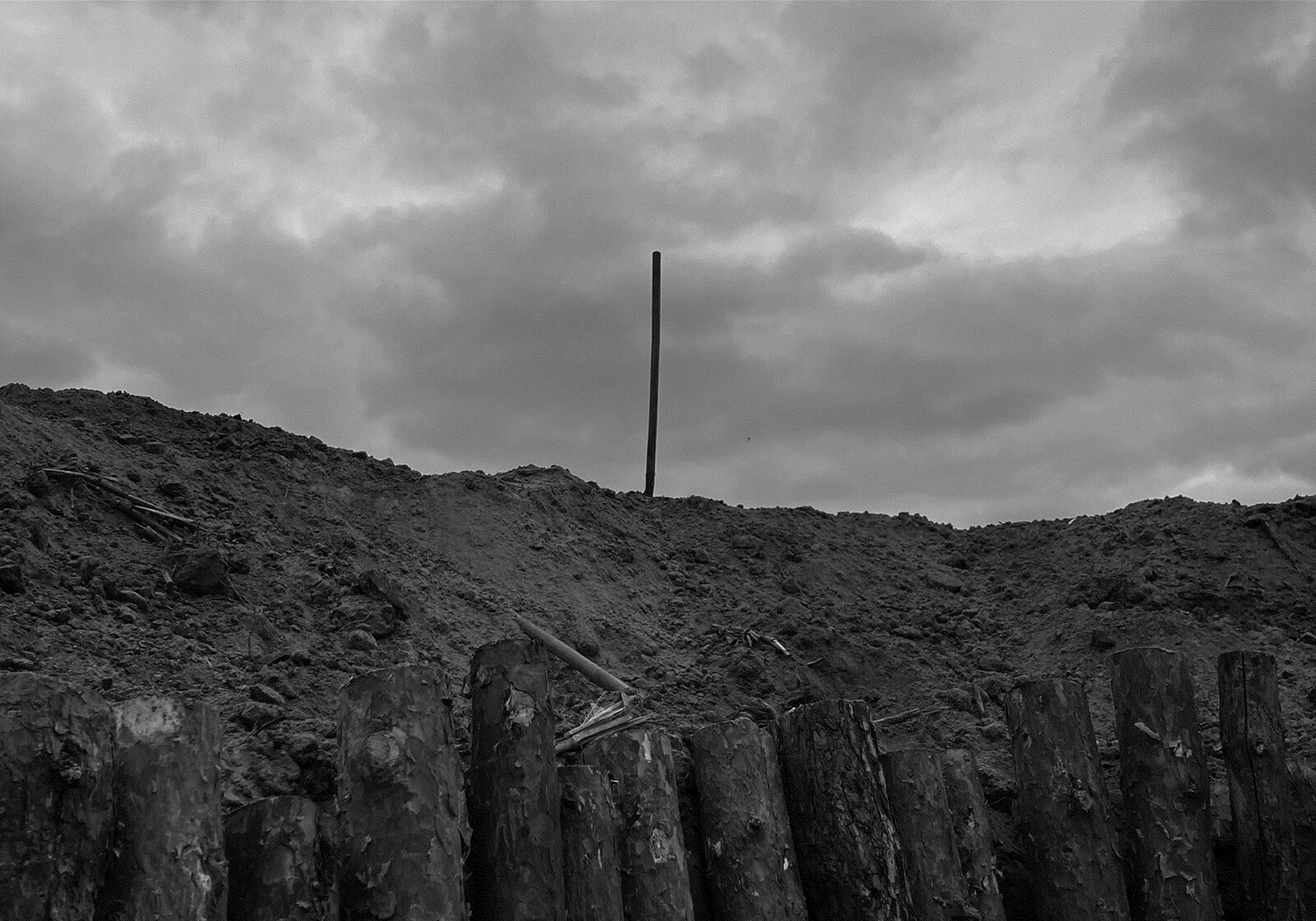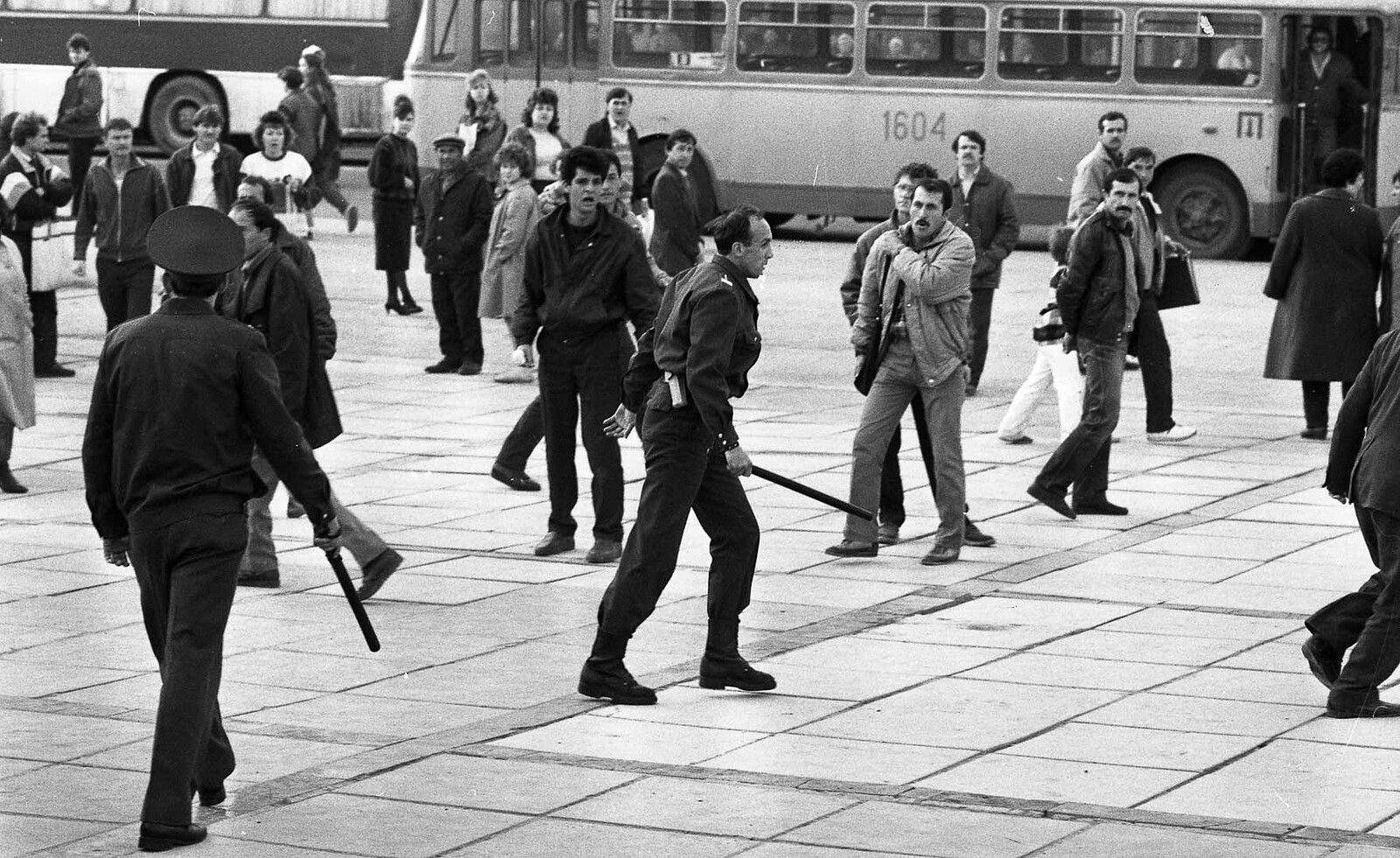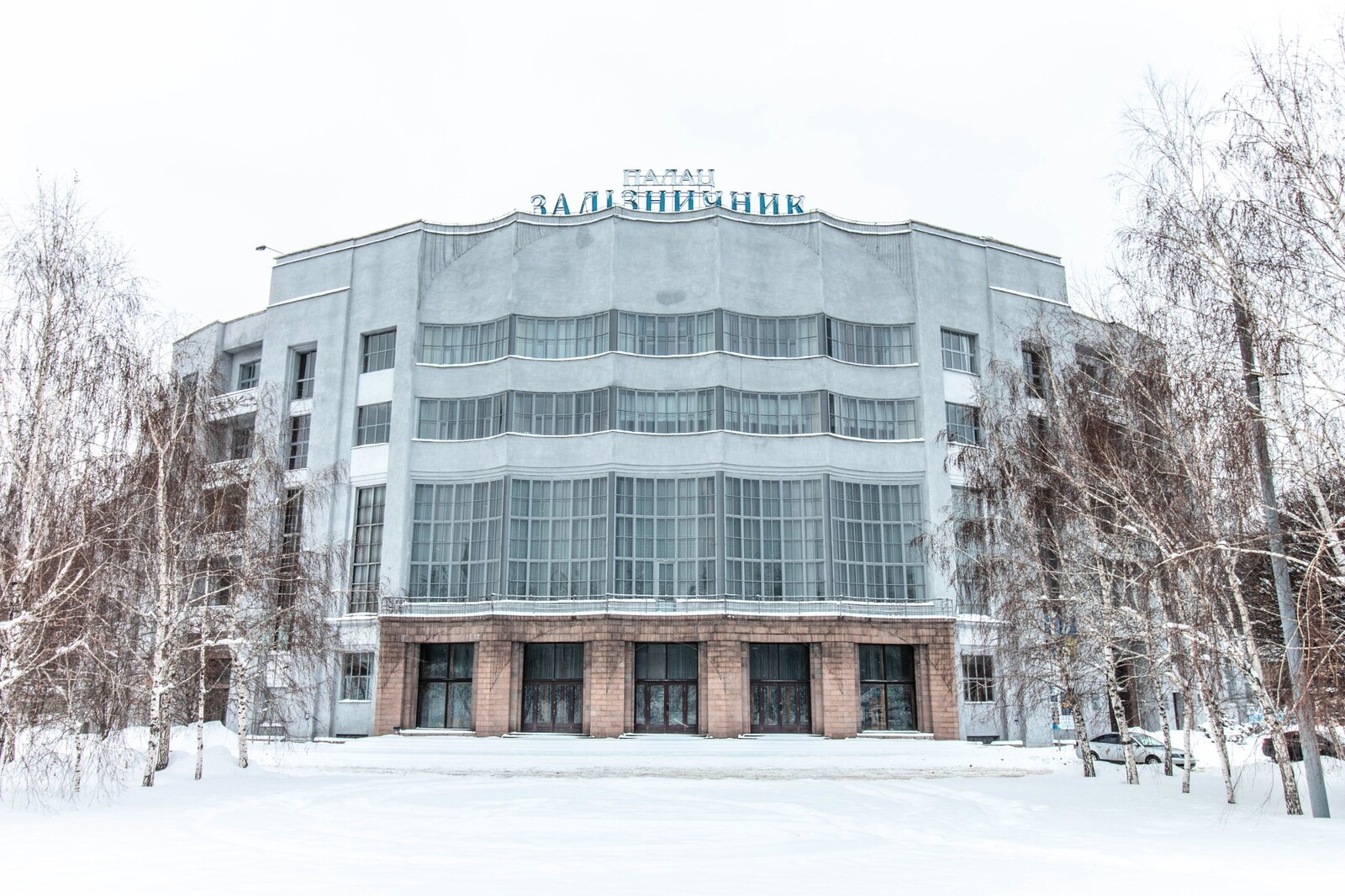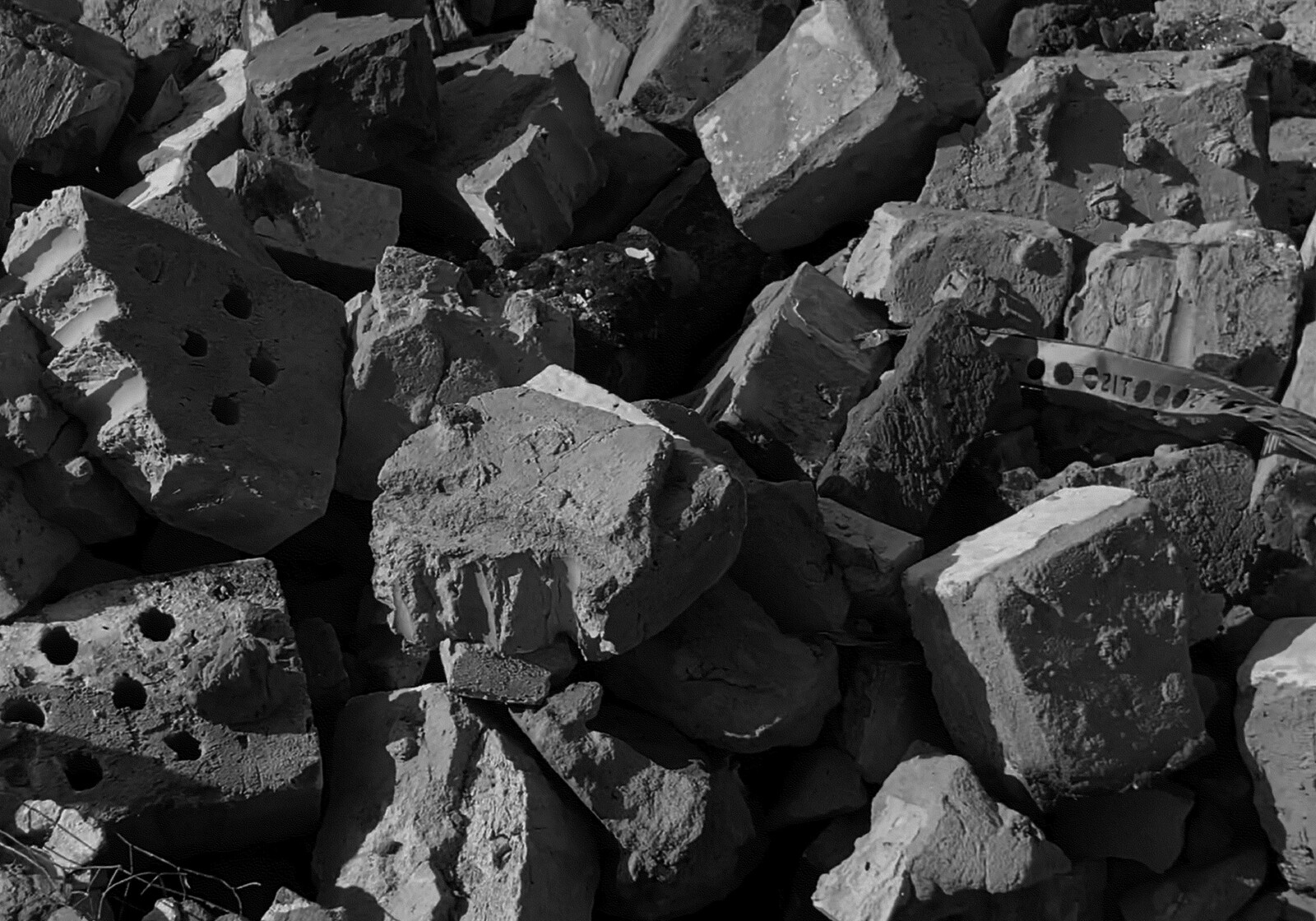The full-scale Russian invasion of Ukraine has caused massive destruction and ruination, particularly targeting cities and the urban fabric. As a consequence of Russian attacks, at least 149,300 residential buildings have been damaged or destroyed.1 At least five million people are internally displaced, 17.6 million require urgent humanitarian assistance, and more than six million fled as refugees by the middle of 2023.2 The scale and the urgency of displacement make physical reconstruction and rehousing a primary concern. Nevertheless, reconstruction should neither be reduced to the act of construction nor be the sole task of urban recovery.
Everyone who has lived through war knows that it brings not only material damage but also leaves embodied after-effects. As a sudden traumatizing event, the experience of war engenders multiple individual states and emotions, as well as multifaceted losses which go beyond simply physical structures. And as part of colonial violence, both past and slow, the Russian war in Ukraine generates other forms of trauma that go beyond individual experience. Through the systemic protracted destruction of networks and connections between bodies, places, and things, such trauma gains a “collective, spatial, and material dimension.”3 This trauma, or rather multiple traumas, is also emplaced in the urban fabric, as cities and the urban way of life has become a particular target of attacks in attempts of what can be called “forced demodernization.”4
Acknowledging trauma in the context of urban recovery poses several challenges related to the technocratic nature of international aid, post-disaster assistance, and even the concept of reconstruction itself—insofar as it pertains to an “aftermath,” and not ongoing colonial violence. For Adrian Lahoud, trauma signifies “that moment after our image of the future is destroyed, but before it has been replaced.”5 Ukrainian recovery plans often give an image of the future that should replace a traumatic moment. However, as colonial violence and war are not a single traumatic event, trauma is never fully an aftermath, but is instead a part of the future.
Accounting for affect within Ukrainian reconstruction projects is difficult, not least because its processes are largely directed by Western institutions and audiences, within which discussions about trauma often lead people to be disqualified as irrational. However, affect is crucial to understanding the multilayered violence of Russian colonial oppression. Indeed, as exemplified by the numerous air raids and bombings of civilian infrastructures like housing, hospitals, shopping malls, and train stations, inflicting pain and trauma are often the point. Dealing with the affective nature and multiple traumas of Russian violence is essential to heal Ukrainian cities.
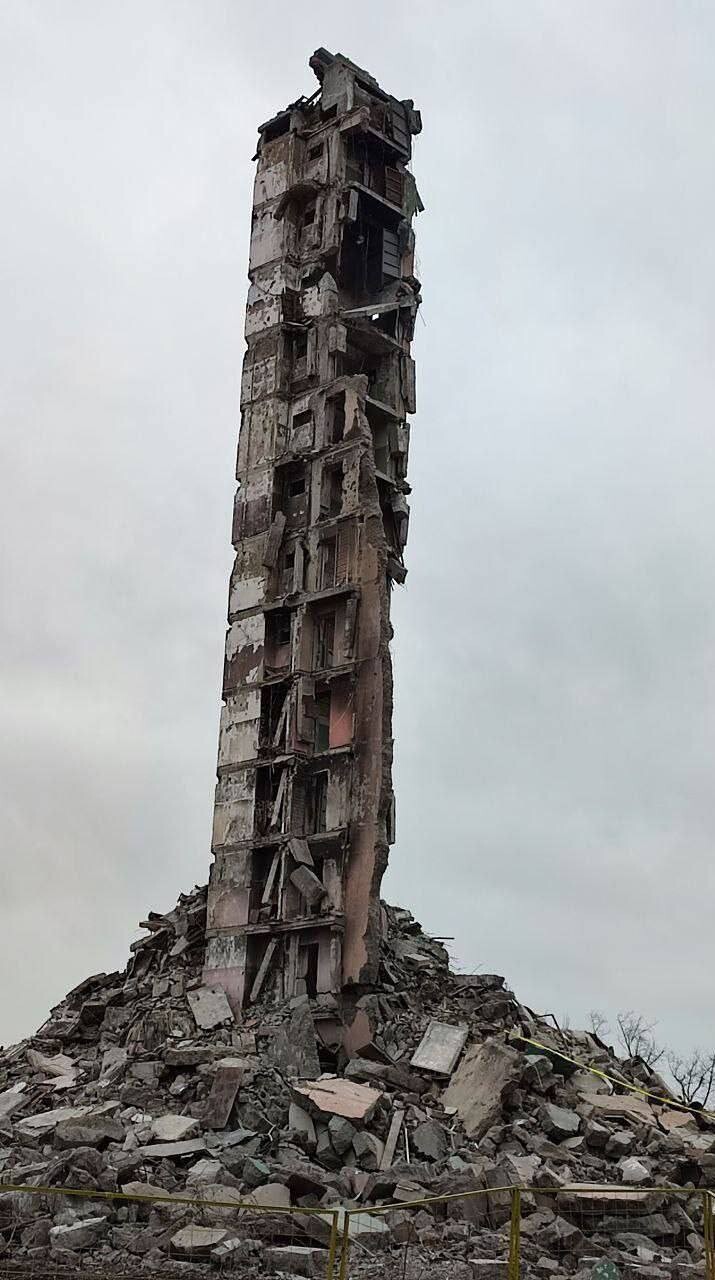

Ruins of Lomyzova 17, Mariupol. Source: Mariupol Now/Telegram, January 25, 2023.
Russian Colonial Violence and Urban Trauma
Russian colonial violence in Ukraine combines different modes of subjugation, annihilation, and punishment. It targets the order of things and the way of life in acts of spontaneous and protracted violence. Particularly, such violence is directed towards the unity of Ukrainian territory and its cities as nodes of modern life. As a result, the trauma of Russian colonial violence is a complex, evolving, and chronic spatial condition.
Some forms of Russian violence, such as air raids and the targeted bombing of civilians in Ukraine, are clearly traceable. Others, however, are more difficult to understand and act upon, as their consequences are dispersed in time and space, such as environmental and infrastructural damage. The effects of environmental violence from warfare can spread far beyond original targets and become visible only years afterward, creating “the difficulty of narrating temporal duration [that] is compounded by the difficulty of narrating physical scale.”6 At the moment of writing, both the environmental and infrastructural damage caused by the full-scale Russian invasion of Ukraine are difficult to access or navigate. With the destruction of the Kakhovska dam, Russian violence escalated into the form of ecocide and urbicide at an enormous scale with unpredictable consequences both in the short and long term. Flooded areas included the city of Kherson and around eighty settlements of different sizes. Around 880,000 people lost access to centralized water supply.7 Hundreds of tons of chemicals, debris, and landmines have floated downstream and into the Black Sea.
Dealing with the acute pain and the urgency to respond to the disastrous consequences of war often leaves few resources to grasp its less tangible effects. For instance, damage to the material fabric and the order of things affects cities as places of ordinary life and the ongoing interactions between humans and non-humans in the making of “their bodies-selves-environments.”8 The familiar position of things is a fixture necessary to practice everyday routines and habitual actions.9 It also serves as connecting points for the unfolding of “ the social relations of memory, and the memory of social relations.”10 The destruction of a physical environment creates a psychological and traumatic break, a disconnection between past selves and possible futures in place. Moreover, without healing, the recovery of destroyed places can create environments of retraumatization in which the future never really comes.
One ongoing example of this is the city of Mariupol, which under temporary Russian occupation has become the site for authoritarian experimentation and rebuilding-as-propaganda. In the first two months of the full-scale invasion, Russian military aggression destroyed the majority of Mariupol’s urban fabric, causing an enormous loss of life and committing war crimes yet to be discovered. At least 22,000 people were killed, and more than 50,000 were deported to Russia.11 Around 90% of infrastructure in the city was ruined, particularly due to direct targeting by Russian forces of non-military targets such as hospitals, the theater, and housing units.12 Immediately after occupying the city, Russia announced reconstruction plans featuring picturesque infrastructural developments such as bicycle lanes and new housing units. The plan, which is projected to run until 2035, in an attempt to propagate the long-lasting nature of the occupation, and copies large parts of existing Ukrainian development plans for Mariupol, from 2012 and 2017.13 It promises the growth of the city and its population, despite the vast depopulation caused by Russian atrocities and widescale destruction. From its pre-war population of 430,000 inhabitants, it is expected that only around 90,000 people are left in Mariupol today. Beyond any activities actually taking place on the ground, however, the Russian reconstruction plan is an element of information warfare. This peaked with Putin’s visit to Mariupol on the night of March 17, 2023, the same day when the International Criminal Court issued a warrant for his arrest for the unlawful deportation of Ukrainian children to Russia.
Claiming to rebuild the city for the “freed” people of Mariupol, the Russian reconstruction project aims to hide the traces of Russian crimes, ensure assimilation and acceptance of the Russian regime, and propagate the idea of peace on Russian terms, both for its own audience and also for Western and foreign ones. In colonial tradition, its main purpose is to replace a Ukrainian city with a Russian one, including the replacement of its population with more loyal subjects. Multiple reports indicate that Russia outsourced the dirty work of cleaning the ruble and construction to its racialized minorities and migrants from Central Asian countries like Uzbekistan, Tajikistan, Turkmenistan, Kazakhstan, and Kyrgyzstan, who were lured by false promises of free accommodation, meals, and high salaries.14 It has also been reported that these workers were promised Russian citizenship after their relocation and settlement in Mariupol.15
As of summer 2023, Russian occupational authorities in Mariupol have demolished 282 multi-story apartment buildings and are planning to demolish around 700 more, which accounts for almost half of all housing in the city.16 Russian reconstruction plans for Mariupol do not include the restoration of social ties, families, and neighborhoods. On the contrary, Russian occupational authorities have sought to establish control and divide the minority of Ukrainians left into those who are loyal or ready to express loyalty to Russia, and those who are not. According to multiple reports, access to basic social services, health care, and the legal recognition of property rights is only given to Ukrainians in Mariupol if they take a Russian passport.17 Reconstruction in this way is not a restoration of normal peaceful pre-war life but a replacement of social order with new hierarchies and truth regimes.
After Ukrainian defenses freed the Kyiv Region last year, the world found out about the gruesome crimes of the Russian military forces against civilians in such cities as Bucha, Borodyanka, Makariv, and many others. After de-occupation, Ukrainian authorities, volunteers, local and international journalists, and international joint investigation teams with experts from many European countries started to collect evidence of war crimes that took place in these cities. According to Ukraine’s prosecutor general, there have been 11,000 war crimes committed by Russian forces in the Kyiv region alone.18 Such investigations and the prosecution of war crimes are a necessary step to justice for the victims, remembrance, and healing. However, this is not the case for the cities under occupation. The fast pace of clearing ruins in Mariupol under the pretense of rebuilding, at a time when the majority of people left the city, opens a way to hide any war crimes and free up space for propagandist narratives. Such processes are not a simple step before rebuilding, but a form of colonial oppression that enforces amnesia and enables a continuation of violence.
Recovery and Healing Ukrainian Cities
Ukrainian recovery and healing cannot be thought of as a linear process or one that can be technically approached via a number of specialized disciplines. In cases of protracted colonial violence, both fast and slow, healing and traumatization co-exist and create complex timespaces. Thinking about cities as places of trauma leads to the idea of healing as a nonlinear process of transformation in which full recovery or a return to the prewar status quo is neither possible nor beneficial, even if it is desired. Recovery should not be a process of forgetting, but rather an open future where new modes of common living can be discovered.
The communal dimensions of healing are particularly important when dealing with the collective trauma of colonial violence. According to the survey and analysis of Ukrainian think-tank Cedos, the full-scale Russian invasion heightened a feeling of solidarity in Ukraine, as well as people’s understanding of the importance of participation in socio-political processes. The respondents of the survey also indicated the desire to be useful and be included in wider social discussions and Ukrainian victory.19 Indeed, the full-scale invasion has resulted in a wave of socio-political mobilization.
While a significant volunteering movement has emerged dedicated to supporting the Ukrainian army or directly helping the victims of Russia’s spectacular violence, part of civil society has been focused on recovery and reconstruction. Such initiatives often work on multiple scales, from policy-making and urban planning to forensic architecture, clearing rubble, and rebuilding homes and public infrastructures. Instead of propagating one vision, plan, or narrative for urban reconstruction, these bottom-up initiatives all promote multiple and common ways of dealing with space and possibilities for healing.
Initiatives such as Building Ukraine Together (BUR), Brave to Rebuild, and Repair Together focus on the restoration of damaged houses and public infrastructures, bringing small groups of volunteers from Ukraine and abroad to communities affected by war. BUR started its activity already in 2014 by organizing volunteer camps for youth in Eastern parts of Ukraine damaged by war. Brave to Rebuild and Repair Together began organizing rubble clear-ups and restoring damages in de-occupied cities in more short-term gatherings since the beginning of the full-scale Russian invasion.
Initiatives such as these work on a relatively small scale in comparison to the scale of destruction. For instance, in 2022, Repair Together cleared up around 120 houses and repaired thirty.20 Their significance, however, goes beyond the fulfillment of utilitarian function. The process of cleaning is organized in a way to allow for the trauma of ruination to be dealt with. Rebuilding is done collectively, with working together becoming an embodied cultural practice. Repair Together combines the clearing of rubble with cultural events such as raves and concerts, and in late 2022 organized an open-air exhibition called “The Stone” in eight European cities about the loss of homes in Ukraine.21 BUR offers different educational programs for young people to develop their leadership skills. Overall, such efforts bring relief in dealing with the destruction, but they also provide spaces for long-term healing through the building of local and trans-local communities, securing a network of support to imagine a better future.
Alongside these grassroots initiatives, multiple Ukrainian architectural and planning initiatives have developed plans for occupied or destroyed cities. While Russia tries to erase Ukrainian cities and build new ones over their ruins, Ukrainian urban planners, architects, and policymakers try to recover and remember what we know about these cities, their complex histories, inhabitants, and traumatic events. Their plans for the future account for the past, the present, and the unknown.

Render of new railway station, offices, and leisure spaces around the transformed Azovstal skyline. Image by Team Fulco Treffers & Ro3Kvit.
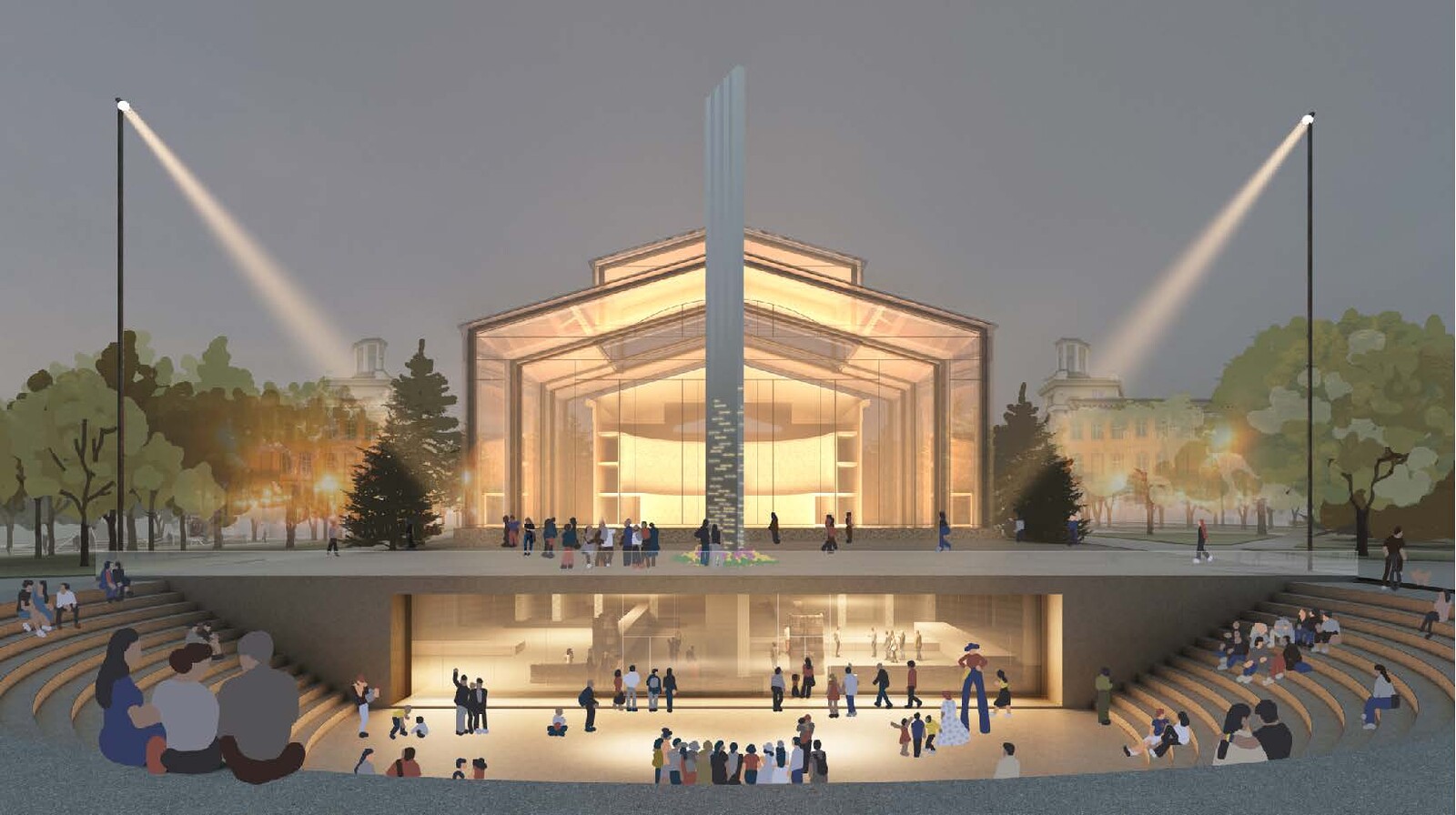
Render of the “Drama Theatre” Centre of Memory. Image by Team Serhiy Rodionov.
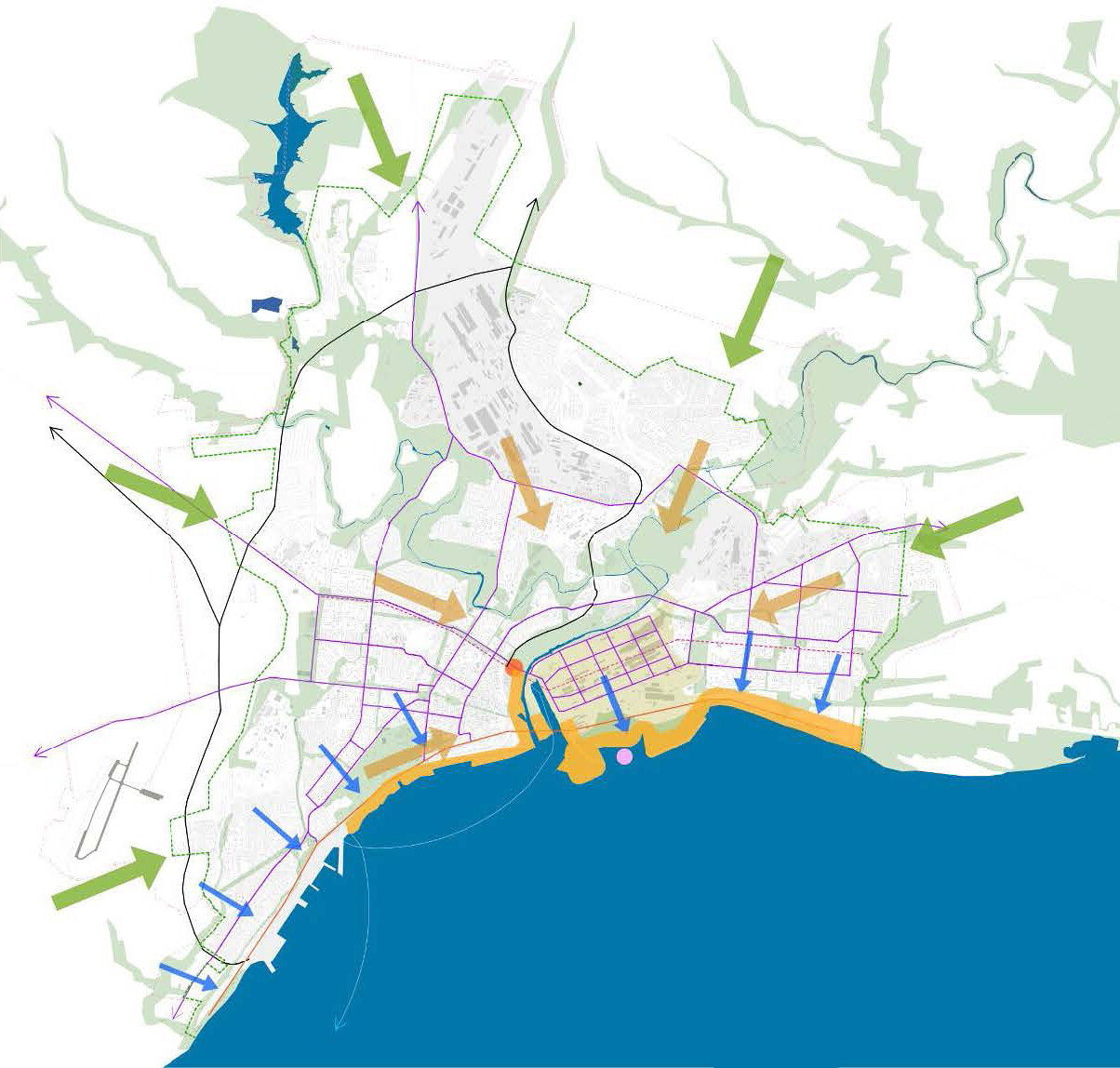
Densification strategy. Image by Team Viktor Zotov.
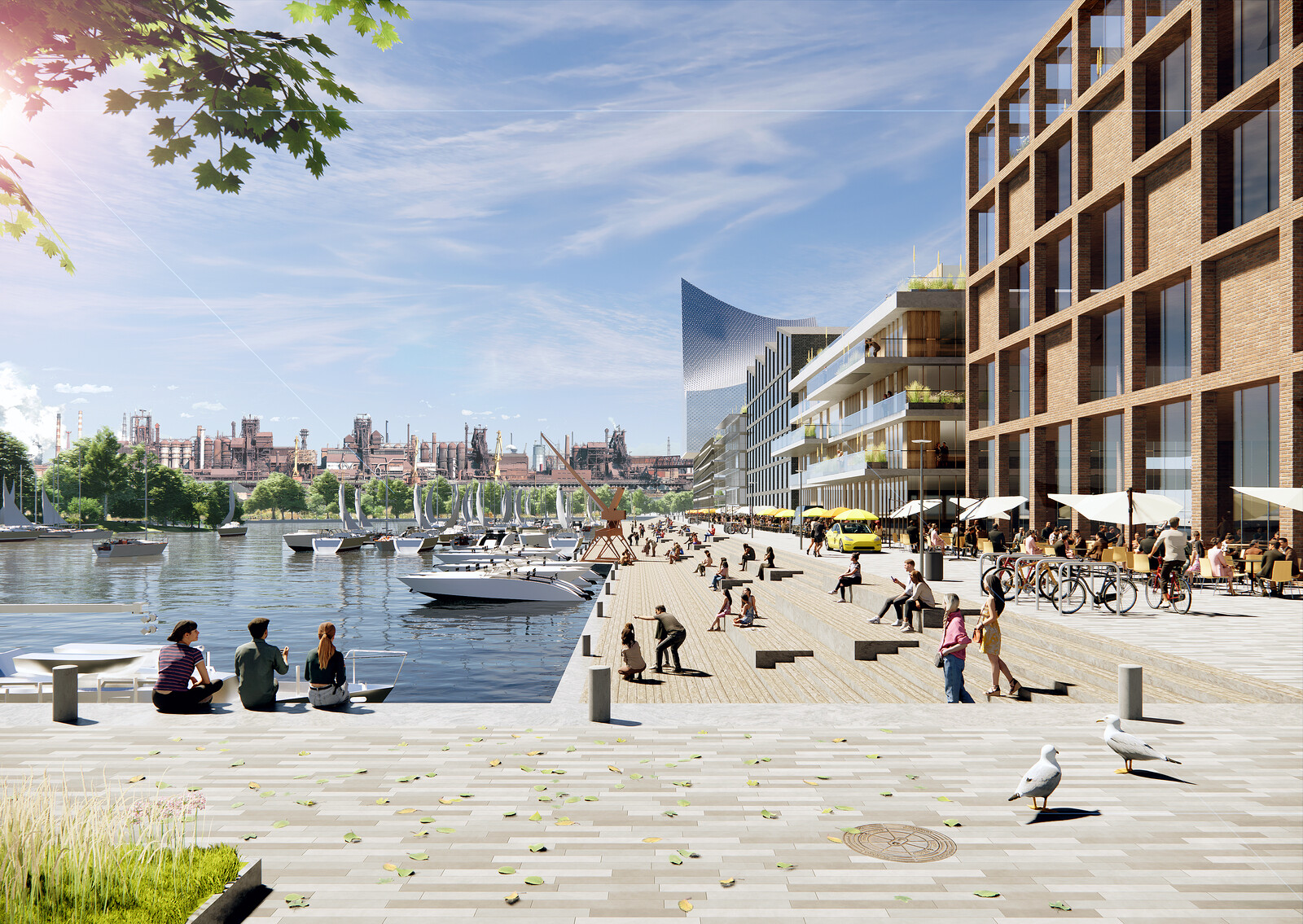
Redner of waterfront neighborhoods. Image by Team BigCityLab.
Render of new railway station, offices, and leisure spaces around the transformed Azovstal skyline. Image by Team Fulco Treffers & Ro3Kvit.
Mariupol Reborn, for instance, is a project by the Mariupol City Council in cooperation with multiple local and international partners, as well as the municipalities of Utrecht, Vilnius, Gdansk, and Lviv, which recently presented four different plans for the redevelopment of the city.22 None of the proposals present a final image or answer of what the city should be. Instead, the final plan will be elaborated further with Mariupol citizens. That said, the plans work with places of trauma such as the Mariupol Drama Theater and the Azovstal steel plant to propose places of remembering. On top of this, they assess environmental damage and seek sustainable urban planning solutions such as the introduction of green corridors or the reduction of the city’s territory. One plan, developed by the Ro3kvit coalition, worked with the stories and memories of citizens of Mariupol about life in the city before the invasion and their survival. This process of collective imagining allows for connections to be made between the past, despite its trauma, to the future.
The multiplicity of proposed futures, mobilization of solidarity networks and volunteering groups, and collaborative building and recovery plans provide instruments for healing urban trauma as a collective condition. However, as the Russian military aggression toward Ukraine continues, individual suffering and traumas multiply. The diversity of individual experience, loss, and pain is not negated by the recognition of collective trauma. Taking into account the scale of displacement and destruction, civil society and volunteering alone can neither solve the enormous housing crises and repair infrastructures nor guarantee justice and social welfare. Despite its impressive scale after the invasion, civic mobilization provides sporadic relief for a limited number of people. It cannot assure just distribution of help, fair inclusion in the processes of reconstruction, or long-term environmental repair caused by large-scale damage.
There is still a pronounced need for complex government-led reconstruction efforts with multiscale coordination, diligent spatial planning, and strategic thinking. Such efforts, though, should never be fully technocratic, top-down, and separated from civil society and community. Urban recovery in Ukraine is not only about physical repair. It is also the process of healing. Physical repair alone can be employed as a continuation of violence, further displacement, and forgetting. The concept of urban trauma is a call to rethink urban reconstruction processes in an embodied way, one that accounts for both individual differences and the commonness of traumatic experience.
“The total amount of damage caused to Ukraine’s infrastructure due to the war has increased to almost $138 billion,” Kyiv School of Economics, January 24, 2023. See ➝.
“Ukraine Emergency,” UNHCR, retrieved August 17, 2023. See ➝.
Michael Rothberg, “Decolonizing Trauma Studies: A Response,” Studies in the Novel 40, no. 1–2 (Spring & Summer 2008): 224–234.
Stephen Graham, “Switching cities off,” City 9, no. 2 (2005): 169–194.
Adrian Lahoud, Charles Rice, Anthony Burke, Post-Traumatic Urbanism (London: John Wiley, 2010).
Rob Nixon, Slow Violence and the Environmentalism of the Poor (Cambridge: Harvard University Press, 2013).
Dmytro Novitskyi, “The undermining of the Kakhovskaya HPP: four categories of consequences and a plan for further actions,” Epravda, June 14, 2023. See ➝.
Karen E. Till, “Wounded cities: Memory-work and a place-based ethics of care,” Political Geography 31, no. 1 (January 2012): 3–14.
Tim Edensor, “Waste Matter—The Debris of Industrial Ruins and the Disordering of the Material World,” Journal of Material Culture 10, no. 3 (November 2005): 311–332.
Michael Mayerfeld Bell, “The Ghosts of Place” Theory and Society 26, no. 6 (December, 1997): 813–836.
Iryna Tsekhosh, “Mariupol: News from the Occupied City,” Ukraïner, June 16, 2023. See ➝.
Ibid.
Elmira Ettinger, “This Is All for Show”: How Russians are Rebuilding Mariupol,” Bird In Flight, March 30, 2023. See ➝.
Sher Khashimov, “By Sending Migrants to Ukraine, the Kremlin is Damaging Ties With Central Asia,” Carnegie Polikita, March 30, 2023. See ➝.
Anthony Bondarchuk, “Occupied. How and Why Russia is ‘Rebuilding’ Mariupol,” Dzerkalo Tyzhnya, June 10, 2023. See ➝.
Ibid.
Oleksandr Viunskovskyi, “Occupiers in Mariupol Force Teachers to Obtain Russian Passports,” Suspilne, June 9, 2023. See ➝.https://suspilne.media/502531-pogrozuut-zvilnennam-i-obmezennami-u-mariupoli-okupanti-zmusuut-vciteliv-otrimuvati-pasporti-rf/? Oleksandr Yankovskyi and Olena Badyuk, “‘Apartment for Three Million in Mariupol’: What Interests Residents of Russia in Occupied Territories?”, Radio Svoboda, July 18, 2023.
Viktoriia Pokatilova, “Ukraine’s Bucha 1 year on: Slow progress in war crime probes,” DW, March 30, 2023. See ➝.
Alina Khelashvili, Anastasiia Bobrova, Yelyzaveta Khassai, Elena Syrbu, Natalia Lomonosova, and Yuliia Nazarenko, “A year of full-scale war in Ukraine: Thoughts, feelings, actions,” Cedos, July 21, 2023. See ➝.
See Repair Together, ➝.
Repair Together, “We believe that young people all over the world can unite and face the global challenges of today,” Instagram, September 4, 2022. See ➝.
“Architects and Urbanists Have Presented Four Visions of the Spatial Development of Mariupol,” Mariupol Reborn, July 7, 2023. See ➝.
Reconstruction is a project by e-flux Architecture drawing from and elaborating on Ukrainian Hardcore: Learning from the Grassroots, the eighth annual Construction festival held in the Dnipro Center for Contemporary Culture on November 10–12, 2023 (2024), and “The Reconstruction of Ukraine: Ruination, Representation, Solidarity,” a symposium held on September 9–11, 2022 organized by Sofia Dyak, Marta Kuzma, and Michał Murawski, which brought together the Center for Urban History, Lviv; Center for Urban Studies, Kyiv; Kyiv National University of Construction and Architecture; Re-Start Ukraine; University College London; Urban Forms Center, Kharkiv; Yale University; and Visual Culture Research Center, Kyiv (2023).
